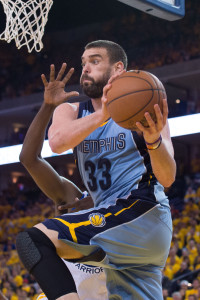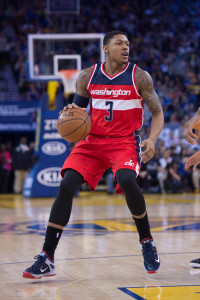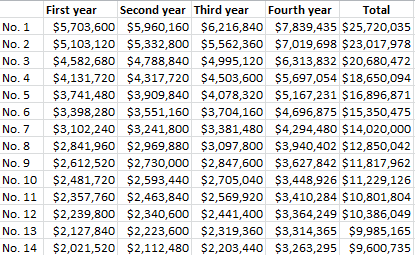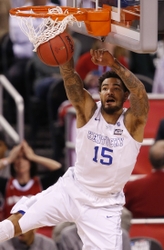If you looked only at his box scores, you would never know that Phil Greene played hurt for the bulk of his four-year career at St. John’s. His teammates, however, knew what he was dealing with. Not wanting to let his locker room down, Greene refused to sit out and heal up, choosing instead to battle through the pain. True to his demeanor, Greene didn’t make a lot of noise about his injuries either.
“I call him the quiet assassin,” former St. John’s coach Steve Lavin said between sips of coffee at a cafe in lower Manhattan. “That’s because he plays within the framework of our schemes and, yet, he had a propensity to step up in crunch time. He made game changing plays, whether it was dagger three-point shots, driving to the basket, or outside shots.”
The guard gave those kinds of performances throughout his tenure in New York, but he really showed what he could do in his senior season when he was 100% healthy. Up until that point, Greene was like a live action Operation board. First, the guard hurt his shooting wrist in his freshman year. Then, as a sophomore, he suffered a hip labrum tear. Prior to his junior year, Greene went under the knife to fix that tear, but he admits that he rushed himself back to action a little too fast.
More than once, Lavin went to Greene and encouraged him to consider a taking a medical redshirt year. The coach also involved Greene’s parents in the conversation, but the guard couldn’t bear to spend a season on the sidelines. Ultimately, Lavin left the decision in Greene’s hands, and he decided to play through the pain.
When asked, Greene wasn’t sure how to quantify how banged up he was, but he knows he was well under 100% for his first three Red Storm seasons. In hindsight, Greene wishes that he wouldn’t have tried to play the hero. The guard might have been playing at MSG, but no one expected him to put on a Willis Reed impersonation.
“Of course, I probably would have taken some time off if I could have done it over again. I should have had my surgery done sophomore year and come back 100%,” Greene explained. “But, now, I’m 100%. I haven’t had a single thing bother me all year long and I’m ready for what’s ahead of me.”
Even with his setbacks in those three years, Greene still managed to be one of the top contributors on a talented St. John’s team. In his senior campaign, Greene got to show the world what he’s truly capable of when healthy. The 22-year-old went out on a high note, averaging 12.9 PPG with a 39.4% rate of success beyond the arc. He was even stronger in conference play, leading the Big East in intra-conference three-point percentage (45.8%) with 14.5 PPG against Big East foes.
Greene had too many big games to count in his last collegiate season, but Lavin and the guard produced the same two answers when asked to list his very best performances. One came against Syracuse when he led the charge on a late game 17-2 run to help St. John’s down the Orange at the Carrier Dome for the first time in 16 years. The other was Greene’s final regular season college game at MSG, when he dropped 26 points on rival Georgetown.
“We hate Georgetown. We hate them. We don’t like them at all,” said Greene, not wanting to leave any ambiguity on the subject. “So, to be at the Garden for my last game and put up 26 points, it was an amazing night.”
Lavin, too, fondly remembers that game.
“Georgetown beat us bad the last time, so we absolutely smashed them there,” the coach said.
With brilliant scoring performances, late game heroics, and a second straight NCAA Tournament appearance, Greene closed out his St. John’s career in style. And, it turns out, NBA teams have taken notice. According to agent Keith Kreiter, Greene has already secured multiple workout invitations and a couple of teams are already showing intense interest in him. As of today, Greene is not featured on ESPN’s or DraftExpress’ mock drafts, but come June, he could very well find a place on the only big board that really counts.
Lavin describes Greene as a player who boasts shot making as his “greatest strength,” but also a player with a very well-rounded skill set. In his senior year, he improved upon his ability to attack the basket and draw fouls, which made him even more dangerous on the offensive end. The Chicago native is also a keen ball distributor and Lavin cites his low assist-to-turnover ratio as one of his most impressive stats. In a league where the ability of a point guard to shoot and score is more important than ever, Lavin sees a bright future for his former pupil.
“He’s fundamentally a very solid point guard, sure, but to me he’s a guard, period. You can put him on the floor and he can pass, catch, handle the ball, and he can create his own shot. One of his greatest strengths is his ability to create his own shot through footwork and his ball handling,” Lavin said. “In the NBA, you’re sometimes isolated with not a lot of room, so your ability to create separation from a defender and make shots is valuable. Phil has shown that he can do that.”
Lavin has also been impressed by Greene’s ability to heat up and take over a game. The coach explained that on several occasions, the guard has given St. John’s scoring stretches of 9 or 10 points at a critical juncture of the game and he does it without forcing offense.
“You could say he’s like a smaller Sleepy Floyd,” Lavin said when asked for an NBA comparison. “Sleepy might have a couple of inches on Phil, but in terms of the ability to knock down shots from a distance and beating opponents off the bounce and nailing mid-range shots, that’s what Phil can do.”
Greene can knock down shots from the outside, but he is also a gifted dunker. One of his latest highlight reel slams had him throwing down a picture perfect alley-oop off a bounce pass from teammate D’Angelo Harrison. The youngster’s primary focus is obviously on contributing in the NBA, but he also has a secondary goal on his check list.
“I’ve thought about being in the dunk contest,” Greene said. “I think I could win it.“




